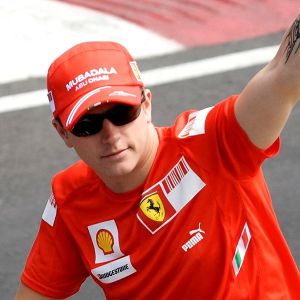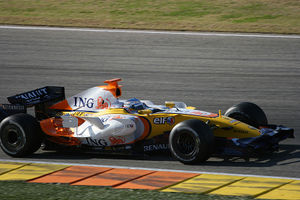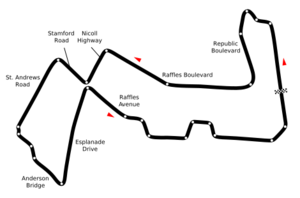Difference between revisions of "2008 Formula One season"
m |
m |
||
| Line 1: | Line 1: | ||
{{X}} | {{X}} | ||
| − | {| align="right" | + | {| align="right"; margin:0 0 .5em 1em; |
| − | |||
| − | |||
{{F1 season | | {{F1 season | | ||
| Previous = 2007 | | Previous = 2007 | ||
| Line 8: | Line 6: | ||
| Next = 2009 | | Next = 2009 | ||
}} | }} | ||
| + | |} | ||
[[Image:Hamilton 2008 Singapore GP 1.jpg|thumb|[[Lewis Hamilton]], champion of the 2008 Formula One season.]] | [[Image:Hamilton 2008 Singapore GP 1.jpg|thumb|[[Lewis Hamilton]], champion of the 2008 Formula One season.]] | ||
[[Image:Felipe Massa 2008 2.jpg|thumb|[[Felipe Massa]], runner-up in 2008 by a single point.]] | [[Image:Felipe Massa 2008 2.jpg|thumb|[[Felipe Massa]], runner-up in 2008 by a single point.]] | ||
Latest revision as of 23:52, 5 February 2011
| 2008 FIA Formula One World Championship season | |
| Previous: 2007 | Next: 2009 |
| Index: Races by country | Races by season | |
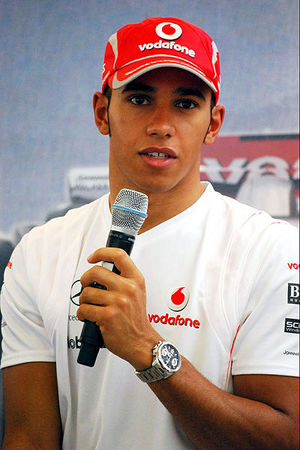
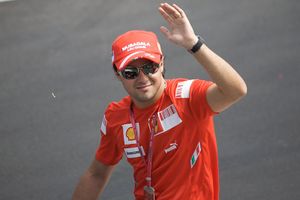
The 2008 Formula One season was the 59th FIA Formula One World Championship season. It began on 16 March and ended on 2 November after eighteen Grands Prix. Lewis Hamilton became the Drivers' World Champion while Scuderia Ferrari Marlboro won the Constructors' title. In winning the title, Hamilton became the youngest driver ever to win the title and the first black driver to do so. He was also the first British champion since Damon Hill in 1996.
There were a total of seven teams signed up to compete in the championship through an agreement with Formula One Management, with the other four major manufacturers in the Grand Prix Manufacturers’ Association (GPMA) having signed a Memorandum of Understanding (MoU) at the 2006 Spanish Grand Prix. All teams in both groups have two spots each on the 2008 grid. One for each of their drivers determined through Qualifying on the Saturday of the race weekend (Sunday hosting the Grand Prix). The season sees the banning of traction control after it was re-introduced in 2001. 2008 also introduced two new street circuits. The Valencia Street Circuit and Marina Bay Street Circuit hosted the European GP and the new Singapore GP respectively. The Singapore GP was also the first Formula One event held at night.
Pre-season testing
The first multi-team test session started in Jerez on 14 January 2008. Ferrari, McLaren and Toyota all tested their 2008 cars. Williams tested a modified version of the FW29 whilst Renault and Red Bull tested their 2007 entries. Honda, Toro Rosso, Super Aguri and Force India also attended. BMW was not in attendance as they were launching the F1.08 Testing then moved to Valencia on 22 January. Renault and Williams were the only teams on the track for the first day of testing. They were both testing their 2008 challengers. They were joined by every other team except Super Aguri for the next three days. 1 February saw testing move to Barcelona. Again, all teams but Super Aguri were in action. The first day of testing saw Kazuki Nakajima crash his FW30. It also saw racist abuse directed at Lewis Hamilton. Williams withdrew from testing on day three to try to fix the problem that caused Nakajima's crash. Meanwhile on 4 February, Ferrari and Toyota moved to Bahrain to continue testing the F2008 and TF108.
On 12 February testing returned to Jerez. Red Bull and Williams were the only teams in action on the first day. The second day of testing saw all teams but Ferrari and Toyota (who were still in Bahrain) attending. After postponing their SA08 launch and cancelling testing at Valencia, Super Aguri turned up to test their SA07B interim car for the first time.
Testing moved to Barcelona on 19 February. The first day of tests got underway in rain with Williams, Red Bull, Renault and Toyota present. Nico Rosberg topped the time sheets for Williams. BMW Sauber were instead testing on their own in Jerez. Super Aguri did not turn up despite promising a Q&A with the media. They blamed circumstances beyond their control. On the second day Ferrari turned up and topped the time sheets with Felipe Massa on another wet track. McLaren joined on the final day and Williams finished on top with Nakajima. The final multi-team test began on 25 February with every team but Super Aguri attending. Lewis Hamilton topped the time sheets faster than both Kimi Räikkönen and Michael Schumacher. McLaren continued to outpace Ferrari on day two with both drivers on top and Toyota were fastest with Jarno Trulli on the final day.
Teams
On 14 February 2006 the FIA president Max Mosley announced that all teams interested in competing in the 2008 World Championship would have a seven-day window during which they would have to submit an application to compete. All eleven current teams applied, as well as several others. On April 28, 2006 the FIA announced that all of the current teams' applications for the 2008 season were granted, along with a new team Prodrive, fronted by the ex-BAR and -Benetton principal David Richards. There were 21 applications (including the current teams and Prodrive), of which the following were notable: European Minardi F1 Team Ltd, Jordan Grand Prix, Direxiv and Carlin Motorsport. However despite the Prodrive application being accepted Richards later announced that the team would not race in 2008 due to a dispute over the legality of customer cars.
Teams signed with FOM
GPMA manufacturers (MoU with FOM)
Bernie Ecclestone had signed an agreement with the GPMA to end their threat of a breakaway series in 2008.
- BMW Sauber
- Honda
- McLaren-Mercedes
- Renault (Renault have since left the GPMA)
On 29 July 2008, the Formula One Teams Association (FOTA) was formed at a meeting of the teams competing in the 2008 championship. This new organization gives a united voice in ongoing discussions regarding the future of Formula One with the FIA and Bernie Ecclestone's Formula One Group. Headed by Ferrari president Luca di Montezemolo, the first task of FOTA will be to negotiate the terms of the new Concorde Agreement, the commercial contract which governs the championship, with the FIA and Bernie Ecclestone.
New car launches
| Constructor | Chassis | Launch date | Launch location |
|---|---|---|---|
| Ferrari | F2008 | 6 January | |
| McLaren-Mercedes | MP4-23 | 7 January | |
| Toyota | TF108 | 10 January | |
| BMW Sauber | F1.08 | 14 January | |
| Red Bull-Renault | RB4 | 16 January | |
| Honda | RA108 | 29 January | |
| Renault | R28 | 31 January | |
| Force India-Ferrari* | VJM-01 | 7 February | |
| Williams-Toyota | FW30 | No official launch | |
| Toro Rosso-Ferrari* | STR3 | No official launch | |
| Super Aguri-Honda | SA08 | No official launch | |
* Team started the season with updated versions of their 2007 car.
Notes
- Super Aguri originally planned to unveil their 2008 challenger, the SA08, in Barcelona on 19 February but due to financial problems they had to postpone the launch and replace it with a Q&A session with the media which was later cancelled itself. On 10 March, just before the Australian Grand Prix, team boss Aguri Suzuki revealed that their 2008 challenger would be unveiled on March 14 during Friday practice.
- Renault and Honda both started testing their 2008 cars a week before their official launch.
- Although they did not have an official launch, Williams-Toyota gave the FW30 its track debut on 21 January at Valencia during winter testing with a livery of former Formula One drivers on the nose cone who have driven for Williams in the past 30 years. Their season livery was revealed at their photography studio in Oxfordshire on 3 March.
- Toro Rosso-Ferrari started the 2008 season with an updated B spec version of their 2007 STR2 car stating that their 2008 challenger, the Toro Rosso STR3, was due to make its debut at the fourth or fifth round. The new car made its test debut in the hands of Red Bull junior driver, Brendon Hartley in Italy on 2 April, and was also tested by Sébastien Bourdais. The car made its public debut in Barcelona on April 16. It was later confirmed that the car would first race in Monaco.
Teams and drivers
The following constructors and drivers participated in the 2008 Formula One season.
† Toro Rosso started 2008 with a modified version of their 2007 car, labelled the STR2B. The Italian team originally planned to introduce the new STR3 around the fourth or fifth round of the 2008 championship, but it finally made its debut in the sixth round, the Monaco Grand Prix.
‡ Super Aguri withdrew on 6 May from the 2008 Formula One season due to financial troubles.
2008 was the first season where no driver was replaced during the course of the season. Usually some drivers are replaced either for an injury, a lack of performance or sponsorship related issues.
2008 race schedule
The FIA World Council approved the 2008 schedule on 24 October 2007. Singapore was Formula One's first ever night race.
† New circuits
‡ Night Race
Changes
Rule changes
ECU
- A standard Electronic Control Unit (ECU) was supplied by Microsoft MES, a joint venture between Microsoft and McLaren Electronic Systems.
- Traction control and launch control banned along with several other electronic aids including engine braking.
Engine and gearbox
- Max Mosley proposed an engine freeze for ten years. Later, all teams agreed to shorten the engine freeze to five years.
- The first unscheduled engine change of the season for each car did not lead to the usual 10 place grid penalty.
- Fuel of the cars must have been made up of at least 5.75% biological materials.
- Gearboxes to last four races, 5 place grid penalty for a gear box change. If a driver did not finish a race, he was allowed to change the gearbox for the next race without receiving a penalty.
Cars
- Improved cockpit protection.
- The use of a spare car was restricted. Each competing team would not be allowed to have more than two cars available for use at any time. In this context, a car was considered as such if it was a partially assembled survival cell, fitted with an engine, any front suspension, bodywork, radiators, oil tanks or heat exchangers.
Tyres
- Bridgestone will be the official tyre supplier for the 2008-2010 seasons.
Qualifying
- The first part of qualifying lengthened to 20 minutes, and final part of qualifying shortened to 10 minutes. Teams taking part in Q3 would no longer be allowed to add fuel back to the car after qualifying to eliminate 'fuel-burn' phase.
- A minimum lap time for each qualifying session was implemented from Round 3 in Bahrain to stop cars coasting back to the pits at dangerously low speeds as seen in Round 2 in Malaysia. Both Lewis Hamilton and Heikki Kovalainen were demoted five grid places after the stewards decided that they had impeded Nick Heidfeld and Fernando Alonso. The minimum lap time was different for each race. For example, it was 1:39 in Bahrain.
- From 8 May 2008, the FIA announced that, following Super Aguri's departure from Formula One, the qualifying procedures changed. Rather than six drivers being eliminated at the end of Q1, only the five lowest-qualified drivers would be eliminated. This increased the likelihood that one of the midfield contenders would drop out, as only the top 15 drivers would go through to Q2. The Q2-Q3 transition remained unchanged.
Testing
- No competing team was allowed to carry out more than 30,000 km (18,641mi) of testing during the 2008 calendar year.
Driver changes
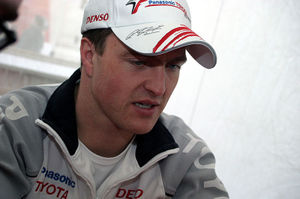
Changed teams
- Fernando Alonso: McLaren → Renault F1
- Heikki Kovalainen: Renault F1 → McLaren
- Giancarlo Fisichella: Renault F1 → Force India
- Nelson Piquet Jr.: Renault F1 (test driver) → Renault F1 (race seat)
- Timo Glock: GP2 Series/BMW Sauber F1 (test driver) → Toyota F1 (race seat)
- Vitantonio Liuzzi: Scuderia Toro Rosso → Force India (test driver)
- Kazuki Nakajima: GP2 Series/WilliamsF1 (test driver) → WilliamsF1 (race seat)
- Alexander Wurz: WilliamsF1 → Honda Racing F1 (test driver)
- Christian Klien: Honda Racing F1 (test driver) → BMW Sauber (test driver)
- Sakon Yamamoto: Spyker F1 → Renault F1 (test development driver)
Entered F1
- Sébastien Bourdais: Champ Car World Series → Scuderia Toro Rosso
- Marko Asmer: British Formula Three Championship → BMW Sauber (test driver)†
Exited F1
Notes
† Marko Asmer also drove in the GP2 Series with the FMS International team in 2008.
More information
- Sebastian Vettel replaced Scott Speed from the 2007 Hungarian Grand Prix onwards at Scuderia Toro Rosso and was confirmed as driver for 2008. Team-mate Vitantonio Liuzzi was replaced by four time Champ Car champion Sébastien Bourdais for 2008.
- On 1 October, Ralf Schumacher announced that he would leave Toyota at the end of the 2007 season. He has since joined the German DTM Touring Cars series.
- On 7 October, it was reported that Alexander Wurz had decided to retire from racing.
- On 2 November, Fernando Alonso and McLaren announced that both parties agreed to a ‘mutual parting of ways’.
- On 7 November 2007, Williams announced that Kazuki Nakajima would partner Nico Rosberg for the 2008 season.
- On 19 November 2007, Timo Glock was confirmed as the replacement driver for Ralf Schumacher by Toyota.
- On 7 December 2007, after testing for Force India, Ralf Schumacher said it was unlikely he would return to Formula One.
- On 10 December 2007, Renault confirmed that Fernando Alonso would drive for them this season. He was partnered by rookie Nelson Piquet Jr..
- On 14 December 2007, McLaren confirmed that Heikki Kovalainen would partner Lewis Hamilton
- On 10 January 2008, Force India confirmed Giancarlo Fisichella as first driver and Vitantonio Liuzzi as a test driver. Adrian Sutil had already been confirmed as the team's second driver.
- On 10 January 2008, Alexander Wurz was announced as the reserve driver for Honda after leaving Williams just before the Brazil GP.
- On 2 February 2008, BMW announced that Christian Klien had been contracted as their test and reserve driver for the 2008 season. He worked alongside Marko Asmer who became the team’s junior tester.
- On 4 February 2008, Renault signed Japanese driver Sakon Yamamoto as a test development driver for the 2008 season.
Team changes
- Rumours about the possible sale of the Jordan/Spyker team had been abundant in the paddock throughout the last few months of the 2007 season. Only a year after Spyker bought the team from Midland, Indian billionaire Vijay Mallya bought the team for €88 million, several million more than Spyker paid. On 24 October 2007, Mallya was granted permission to change the team's name to Force India. He also said he would like to keep German driver Adrian Sutil for 2008. Force India had a driver announcement ceremony in January 2008 where it was revealed that Sutil would be second driver partnered by first driver Giancarlo Fisichella and test driver Vitantonio Liuzzi.
- On 28 April 2006, rallying and motorsports technology firm Prodrive were officially granted entry to Formula One when the FIA announced the list of entrants to the 2008 Formula One World Championship. While a total of 21 teams applied for entry, the FIA had always maintained that only 12 teams would be granted entry, meaning only one new team would line up on the grid in 2008. FIA president Max Mosley revealed that Prodrive had found the finances to support their bid. Also, Prodrive's chief executive, David Richards, has experience as a Formula One team principal". Richards has previously acted as team principal of the Benetton and British American Racing teams. However on 23 November 2007, after lengthy negotiations between FIA president Max Mosley regarding customer cars, Richards announced that Prodrive F1 would not compete in the 2008 Formula One World Championship, as the legal situation left no time for the team to be set up.
- On 31 December 2007, Toyota announced that they would end their sponsorship deal with Kingfisher Airlines due to the fact that Kingfisher Airliners' owner Dr. Vijay Mallya wants to focus on the new F1 team Force India which was formed after Dr. Mallya's 2007 acquisition of Spyker F1 team. Although the team had a two year deal with the Indian airline company, both parties agreed to terminate the deal by 'mutual consent'.
- During the 2008 season on May 6, the Super Aguri team folded and withdrew from Formula One. The team was in dire financial straits at the end of 2007 as the team did not receive a payment on a sponsorship deal. This has led to them becoming the poorest team in Formula One. Super Aguri rejected a buyout offer in January 2008 from an Indian consortium led by the CEO of the Spice Group on the cond. Despite this Super Aguri were unable to sign any contracts until agreements had been reached with their sponsors. Sato and Davidson were confirmed on 10 March.
GP2 series driver Luca Filippi was linked to race for the team in 2008, however he instead stayed with the GP2 series for 2008. Super Aguri announced that a major deal had been made with Magma Group to solve the team's financial problems, however this fell through, supposedly because of Magma Group's unwillingness to invest money in a team with poor results. On 6 May 2008, Super Aguri withdrew from the Formula 1 World Championship<. It affirmed a prediction at the start of the season by Max Mosley saying the team would not make it to the final race in Brazil.
Race changes
- It had been confirmed that Singapore would host a Grand Prix from 2008 for the next five years. It would be a street circuit, with the route designed by KBR. It had been confirmed that the Grand Prix would be a night race, with a start time of 20:00 local time (12:00 GMT) and run in an anti-clockwise direction to enhance safety by avoiding a bottle neck at the end of the start finish straight. It had also been revealed that practice sessions and qualifying would take place at night.
- The European Grand Prix would take place at the Valencia Street Circuit in 2008, changing from the Nürburgring which hosted the event up until 2007. Because both German circuits share the right to host an F1 race, the German Grand Prix took place at Hockenheimring in 2008. It will continue to alternate between these two circuits yearly.
- It had been confirmed that the Indianapolis Motor Speedway would not hold a Grand Prix in 2008; however, a possible return to Indianapolis in the future has not been completely ruled out.
- In the run up to the 2007 French GP it was reported that it would be the last Grand Prix to be held at Magny-Cours. Some alternatives suggested for the French Grand Prix included Paul Ricard or a new circuit near Disneyland Paris or Charles de Gaulle airport. However on 24 July 2007 it was reported that Bernie Ecclestone had "agreed in principle to maintain the race at Magny-Cours in 2008, and even 2009, if there were no other alternatives."
- The 2008 season also saw changes to the race start times for China, moved to 15:00 and Australia, moved from its traditional 14:00 slot to 15:30.
Other changes
- On 7 March, the official Formula One tyre supplier Bridgestone announced that they would be marking their extreme wet weather tyres with a white line in the central groove to differentiate it from the softer wet weather tyre compound. This was so spectators could differentiate between the tyres in the same way they could with the dry compounds.
TV coverage
All broadcasters of Formula One worldwide take what is known as the world feed for the majority of their race coverage. The host broadcaster which produces the world feed has access to trackside, onboard and pitlane cameras. Timing, position and other graphics are also added to the world feed before it is provided to the broadcasters. For the 2008 season, Formula One Management, owner of the commercial rights to the sport acted as host broadcaster for 16 of the 18 rounds of the championship.
- In the Arab world, practice, qualifications and races were broadcast exclusively by Al Jazeera Sports.
- In Australia, qualification was aired early in the morning on the race day. The race had recently been shown live on Ten HD. If it started at 10:00pm AEST, it would be shown later on Network Ten, however if at a different time, it would be shown live.
- In Brazil, all races and qualifications were broadcast by Rede Globo.
- In France, both qualifications and races were broadcast by TF1.
- In Greece ALPHA TV broadcast the Grands Prix live.
- In India, all races were broadcast by ESPNStar alliance, primarily on Star Sports.
- In Japan, Fuji TV broadcast all the races and qualifications, digests in terrestrial channel and live in satellite channel (Fuji CS721) via SKY PerfecTV. In parallel with the two channels, the company started broadcasting high-definition live program in HD satellite channel (Fuji CSHD) after the 2008 Bahrain Grand Prix.
- In Mexico, all races were broadcast live on Fox Sports, and by Televisa's XHTV Canal 4 a few hours later using a tape delay broadcast.
- In Sweden, the qualification was broadcast in both TV 6 and Viasat Motor simultaneously, although Viasat Motor did not have commercials.
- In the United Kingdom, ITV provided the coverage for the last time before the BBC takes over in 2009.
- In the United States, all races were broadcast live on Speed except for four races broadcast by Fox: the 2008 Canadian Grand Prix, 2008 French Grand Prix, 2008 British Grand Prix and the 2008 German Grand Prix. However, only the 2008 Canadian Grand Prix was televised live, and others were tape delayed.
- In Turkey, the races were shown on CNN Turk.
- In Canada, the races were shown on TSN, although in Quebec, it also aired on RDS.
- In Venezuela, all races were broadcast live on Televen, and by Meridiano Televisión a few hours later using a tape delay broadcast.
- In Malaysia, the race is broadcast live on Pay-TV Astro's ESPNStar Star-Sport's channel. Free TV channel RTM's shows the race delayed, and takes the ITV commentary feed.
Results and standings
Grands Prix
Drivers
|
Bold - Pole |
† Drivers did not finish the Grand Prix, but were classified as they completed over 90% of the race distance.
Constructors
|
Bold - Pole |
† Driver did not finish the Grand Prix, but was classified as they completed over 90% of the race distance.
‡ Super Aguri withdrew from the Formula One world championship on May 6, 2008, with immediate effect. The company went into administration a day later.
Statistics
Drivers
Constructors
| Pos | Constructor | Chassis | Engine | Starts | Wins | Podiums | Poles | F.laps | Points |
|---|---|---|---|---|---|---|---|---|---|
| 1 | |
F2008 | Ferrari | 36 | 8 | 19 | 8 | 13 | 172 |
| 2 | |
MP4-23 | Mercedes | 36 | 6 | 13 | 8 | 3 | 151 |
| 3 | |
F1.08 | BMW | 36 | 1 | 11 | 1 | 2 | 135 |
| 4 | |
R28 | Renault | 36 | 2 | 4 | 0 | 0 | 80 |
| 5 | |
TF108 | Toyota | 36 | 0 | 2 | 0 | 0 | 56 |
| 6 | |
STR2B, STR3 | Ferrari | 36 | 1 | 1 | 1 | 0 | 39 |
| 7 | |
RB4 | Renault | 36 | 0 | 1 | 0 | 0 | 29 |
| 8 | |
FW30 | Toyota | 36 | 0 | 2 | 0 | 0 | 26 |
| 9 | |
RA108 | Honda | 36 | 0 | 1 | 0 | 0 | 14 |
| 10 | |
VJM-01 | Ferrari | 36 | 0 | 0 | 0 | 0 | 0 |
| 11 | |
SA08 | Honda | 8 | 0 | 0 | 0 | 0 | 0 |
External links
- 2008 Formula One images Retrieved from www.motorsport.com on 13 November 2008
- 2008 Formula One videos Season review videos retrieved from several video sites
| ||||||||||||||||||||||
| Formula One Championship | |
|---|---|
| 1950 • 1951 • 1952 • 1953 • 1954 • 1955 • 1956 • 1957 • 1958 • 1959 • 1960 • 1961 • 1962 • 1963 • 1964 • 1965 • 1966 • 1967 • 1968 • 1969 • 1970 • 1971 • 1972 • 1973 • 1974 • 1975 • 1976 • 1977 • 1978 • 1979 • 1980 • 1981 • 1982 • 1983 • 1984 • 1985 • 1986 • 1987 • 1988 • 1989 • 1990 • 1991 • 1992 • 1993 • 1994 • 1995 • 1996 • 1997 • 1998 • 1999 • 2000 • 2001 • 2002 • 2003 • 2004 • 2005 • 2006 • 2007 • 2008 • 2009 • 2010 | |
